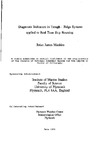Diagnostic Indicators in Trough - Ridge Systems applied to Real Time Ship Routeing
| dc.contributor.author | Manhire, Brian James | |
| dc.contributor.other | Faculty of Science and Engineering | en_US |
| dc.date.accessioned | 2013-10-21T10:06:34Z | |
| dc.date.available | 2013-10-21T10:06:34Z | |
| dc.date.issued | 1992 | |
| dc.identifier | NOT AVAILABLE | en_US |
| dc.identifier.uri | http://hdl.handle.net/10026.1/2242 | |
| dc.description.abstract |
The need for the mariner to have better weather indicators for efficient ship routeing in the middle latitudes is demonstrated. The benefits of an early appreciation of the subtle changes in storm behaviour is shown in a case study. Monitoring of ship's performance through a frontal depression using a modified Tropical Storm Avoidance simulation, also developed by the author, shows the penalties of not minimising the effects of wind and waves. To accomplish the aims of this project diagnostic models are developed, firstly to show the overall movement of the frontal depression within the trough - ridge system and secondly to investigate the field structure appertaining to depression movement and development. The graphical diagnostic model, an animated movie loop, allows the detail from two levels to be combined, surface fronts superimposed on the 500 mb flow, and played back in sequence showing the sophisticated nature of storm movement. This insight naturally lead to the development of a numerical diagnostic model to study simple elements such as wind fields. Analysis of these data enabled a movement indicator for the frontal depression, the "TEN" Indicator, to be formulated and is based on the 500 mb contours. Further improvements in the diagnostic numerical model allows the gradients of synthesised elements to be calculated without the loss of boundary values, and uses a cubic spline technique based on the Lagrange Interpolation. Error analysis of the calculated wind fields is carried out to test the accuracy of the methods employed. The model is then used to analyse a number of depressions using various development techniques to test the model. The results from four occasions, of the many observed, are demonstrated showing the development ideas of Sutcliffe, Petterssen and the Q-Vector based on quasi-geostrophic theory. Divergence is also considered using gradient wind substitutions, adjusted for surface friction and modified to satisfy curvature effects in ridge systems. The four occasions illustrated demonstrates the similarities between each method, the location of vertical motion within a deepening depression is located slightly in advance of the warm front. The normalising of these vertical field indicators against the surrounding flow allows the visual and numerical appreciation of ascent in weak fields. This approach may be an advantage in further studies of cyclogenesis. The model wind fields are tested using operational wind data, both being calculated from the same digitised pressure fields. The Oceanroutes Operational Routeing Model is employed, using these data, to produce two routes using both the analysis and forecast data. The case study demonstrates the usefulness of the "TEN" Movement Indicator as it provides the mariner with the tools to examine depression movement, to check forecasts and to give him the confidence to question routeing orders. This method requires data for the surface and the 500 mb level. Recommendations are suggested to modify the surface weather chart format for the mariner by including both movement and development information which would economise and optimise weather data transmission for greater shipboard efficiency. | en_US |
| dc.description.sponsorship | Plymouth Weather Centre, Meteorological Office, Plymouth | en_US |
| dc.language.iso | en | en_US |
| dc.publisher | University of Plymouth | en_US |
| dc.title | Diagnostic Indicators in Trough - Ridge Systems applied to Real Time Ship Routeing | en_US |
| dc.type | Thesis | |
| dc.identifier.doi | http://dx.doi.org/10.24382/3330 |
Files in this item
This item appears in the following Collection(s)
-
01 Research Theses Main Collection
Research Theses Main


